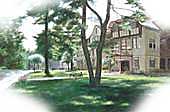Fall
1978
Autonomy, Heteronomy,
and Theonomy
Steve Wilbur
Teacher at Pinecrest Bible Training Center
These three Greek words, autonomy, heteronomy, and Theonomy,
at first sight seem formidable. But we are using them as a
practical means of conveying a captivating set of spiritual
ideas—“The words that I speak unto you they are
spiritual and they are life” (John 6:63). These three
words accomplish this in a most compact and penetrating way.
AUTONOMY
The word is derived from two Greek words, autos meaning self,
and nomos, meaning law. In the beginning God created Adam
an autonomous being. This was his divine constitution; the
Creator made him so. Adam was given no graven tables of stone
as was Moses, neither did he have a book of law as the lawyers
of Jesus’ day. He did not need it. The law of “man-ness”
was within. That is, he became a structure called man, the
pattern emanating from the mind of God being realized.
We can see that the law of “man-ness” was inside
Adam as the genetic code is inside a seed. When we plant a
seed we don’t bury a set of instructions beside it,
neither do we recite an elaborate list of do’s and don’ts
to it, it just grows—autonomously. Here we catch a vision
of that which naturally and normally unfolds—it works
from the inside out. The seed contains within itself the power
to manifest as a mature plant one day.
The Scriptures clearly picture man’s autonomous character.
In Genesis 2:7 God names Adam, but in Genesis 2:19, God brings
the creatures to man and Adam names them. The operation of
the internal law enabled Adam to do this. Accordingly, in
Genesis 2:23 he names Woman.
Had man’s law of being been outside himself, he would
have amounted to a sort of robot—unthinking, unfeeling,
uncreative until he received an input or a command from an
outside source.
So we see each item of creation constituted like man—called
into being as an existing structure and set in its order by
God. Adam in the image of God endowed with free will, invested
with dominion over all creation, is standing at the head of
all other orders of created beings.
It would be wonderful if we could leave matters as they now
stand, an entire creation happily whirring away, each element
obeying its internal principles as given by God. It is at
this point that the tragic element enters the moral and spiritual
universe man had learned to call home. In a moral test, the
weak link in man’s constitution is exposed. It is that
autonomous existence is only safe and harmonious as long as
the obedience implicit in the Creator-creature relationship
is maintained. The autonomous life on Adam was his source
of light. John 1:4: “In him was life; and the life was
the light of men.” “And God breathed into his
nostrils the breath of life” (Genesis 2:7). God life
was Adam’s life. When in rebellion, man disobeyed the
commandment, his light went out (Matthew 6:23b). The command
itself was in accord with it. The external objective demand
of God was in perfect harmony with Adam’s fundamental
need—life.
This event—the fall—revealed the fact that autonomous
life can be turned against the One who made it. Satan’s
history in Scripture revelation confirms this fact. From the
moment man sinned Adam’s spiritual light was extinguished;
at this time, Adamic life veered off the tract of God’s
structured purpose, on a wild career that has dragged all
humanity through the long dark night of sin called history.
History’s main events are underscored with the red pencil
of horror—continual conflict periodically breaking out
in war. So, personal autonomy, detached from its source, deteriorates
into rebellion, selfish individualism, anarchy. Autonomy,
originally meant for good, finally becomes a word with bad
connotations.
HETERONOMY
This word, heteronomy, derives from two Greek words, heteros
meaning foreign, and nomos, meaning law. Man, as he is known
from the dawn of history is observed to be one who preys on
his fellow human beings. Human nature is all too easily brutalized.
This continual drift toward social breakdown necessitates
control. At this point the external law enters. Since man
seems bereft of internal discipline of self-control, he must
be ruled. The law is applied from without—“super-imposed.”
It is “law upon” man.
The coming of the law from outside (heteronomy) will be exemplified
for us by the Mosaic Law. Though it was given to Israel by
the disposition of angels, its end point is carefully described
in the Bible. The end from man’s (psychological) view
point is summed up by Peter in Acts 15:10: “which neither
we nor our fathers were able to bear” referring to the
Law of Moses in verse 5. This poignant statement from man’s
existential depths reveals dramatically the unsatisfactoriness
of the arrangement typically known as “Law.” Some
further solution must be sought from man’s experiential
standpoint.
Not only is man dissatisfied with a kind of existence under
the order of heteronomy, but amazingly enough, God, the author
of the law, is also dissatisfied. The drive to correct this
disrupted fellowship with His creature, man, originates deep
in God. “And the Lord God called unto Adam, and said
unto him, Where art thou?”
The Mosaic Law’s insufficiency in God’s eyes
is demonstrated in His evaluation of it in Hebrews 7:19: “For
the law made nothing perfect.” Again in Hebrews 8:7,
8: “For if that first covenant had been faultless, then
should no place have been sought for the second. For finding
fault with them he said, Behold, the days come, saith the
Lord, when I will make a new covenant with the house of Israel
and with the house of Judah.” A new covenant—a
new arrangement. Words fail to express the delight we experience
at the good news of the approach of the “new,”
for all religious forms ultimately wind up in a relation characterized
by heteronomy—laboriously struggling to fulfill a binding
law we instinctively feel is alien to us.
THEONOMY
This is the word we use to express the new relation. You
can see at a glance it is composed of “God” and
“law” –God law. The Holy Spirit through
the new covenant teaches us that what the world was waiting
for was not a written law—not even a religious law;
we were waiting to receive the Spirit of the Son of God in
our hearts crying, Abba, Father. “He has qualified even
me as a minister of the new covenant, which is not a written
but a spiritual covenant. For the letter kills, but the Spirit
gives life” (2 Corinthians 3:6 Williams Translation).
Let us now compare and contrast the realities symbolized
by these three forms. The obvious beauty of Autonomy is its
inwardness—its integrated nature. Like Samson, it does
not exhibit muscles, it is possessed of a mysterious strength;
that was the source of the Philistines’ fascination
with him. We instinctively admire a horse more than a motorcar,
since his power apparatus cannot be detached without destroying
his integrity as a horse.
On the debit side however, though God vivified man with the
breath of Life—that resultant life found it possible
to exist without a sense of God somewhere outside the Manifest
Presence (Genesis 3:9). This represents from God’s view
point a fallible life-form, failing of God’s intent.
Heteronomy (the Law) on the other hand exists as a brittle,
objective reality, unchanging in it s moral grandeur. “Wherefore
the law is holy, and the commandment holy and just, and good”
(Romans 7:12). “For we know that the law is spiritual”
(Romans 7:14a). And frustrating. Because it is outside man.
Paul expresses ultimate frustration in chapter seven of Romans.
Confucius provides a similar frustration for the Chinese,
in a like situation as Romans 7:24: “O wretched man
that I am! Who shall deliver me . . .” They are bequeathed
an ethic minus the inner dynamic—the enablement (grace)
to be and to do. But Romans eight opens with the dominant
paean of praise of the new creation man who finds realized
in himself the Law of the Spirit of Life in Christ Jesus.
This note of triumph is echoed and re-echoed in the Prophets
and the New Testament. No longer does the perfect objective
tantalize us from without. No longer are we reduced to merely
our own fallible selves, bankrupt of power to be.
At this point of ultimate existential crisis, Christ comes
in, bringing in His Person all the longed for perfections
of the “Law.” “Think not that I am come
to destroy the law, or the prophets; I am not come to destroy
but to fulfill.” Thus, He marries His infallibility
with our fallibility. His Wisdom with our dull stupidity and
His Freedom with our parochial imprisonment in “our”
time and “our” space. What emerges from this cataclysmic
encounter of the human with the divine is nothing less than
a new creation. 2 Corinthians 5:17, the essence of “Christian,”
“Christ in you, the hope of glory” (Colossians
1:27).
Here we have the blending of opposites: the Inner (Autonomy)
and the Outer (Heteronomy) in a new state of being that is
(according to Scripture and history) satisfying both to God
and His Man. Here is an Autonomy thinking, feeling, and willing
Theonomously. The new Autonomy is deeply and permanently imbued
with the sense of the Divine. It lives and moves and has its
being in God. Its standard measure is set forth in an oft
neglected verse of Scripture that immediately follows an oft
quoted one: “And all things are of God.”


